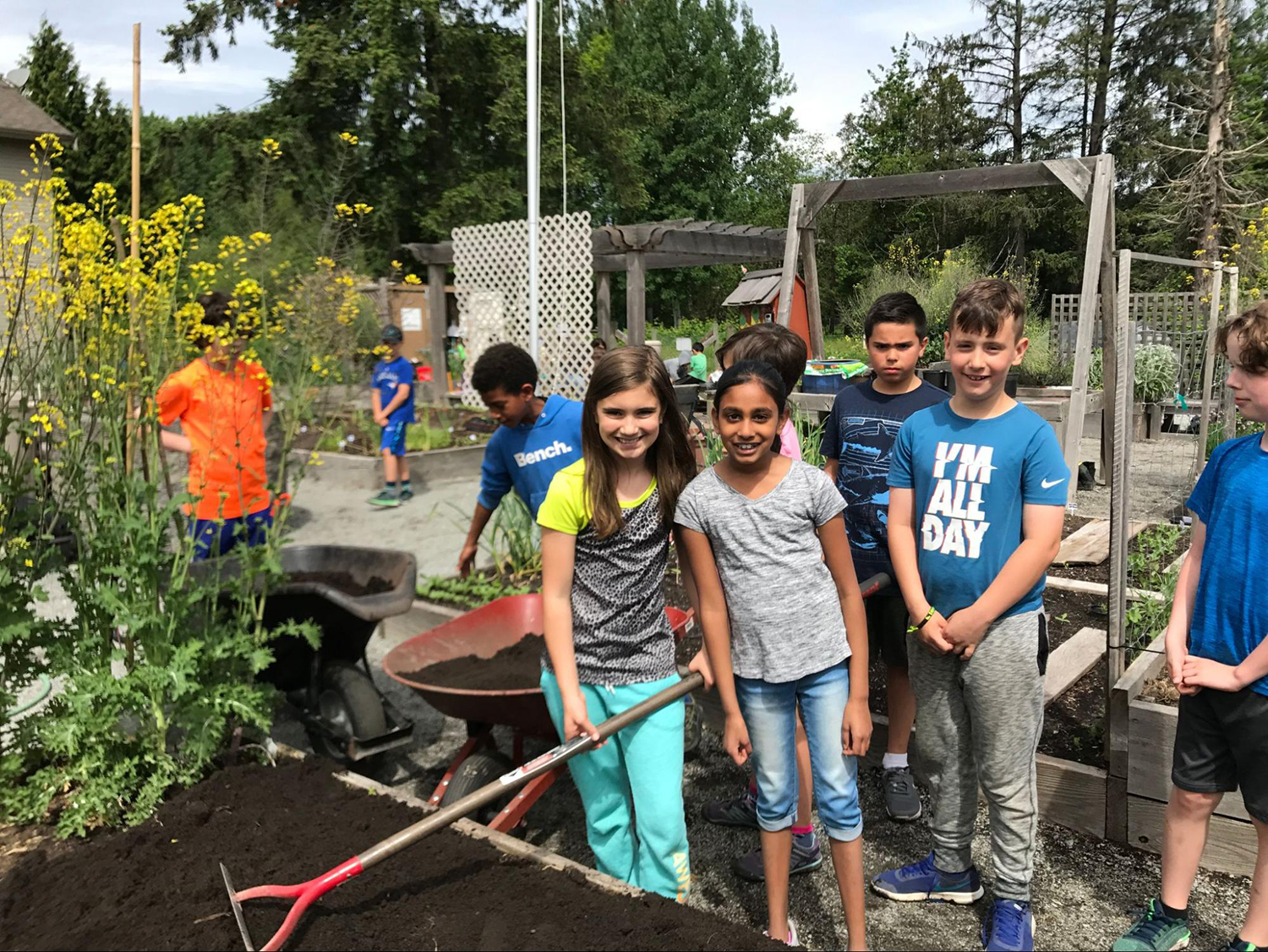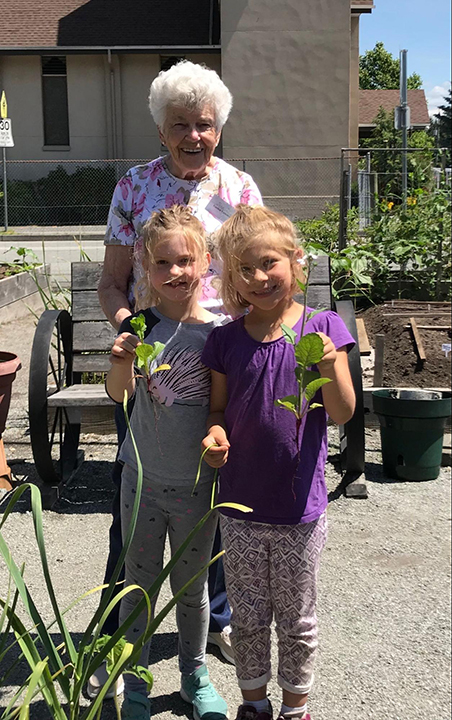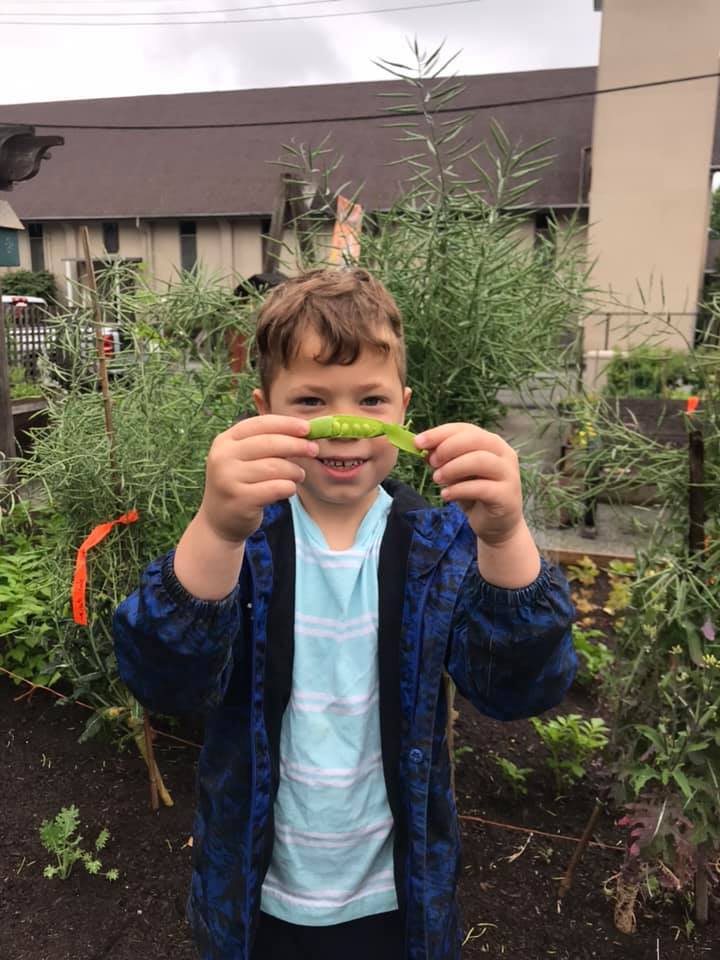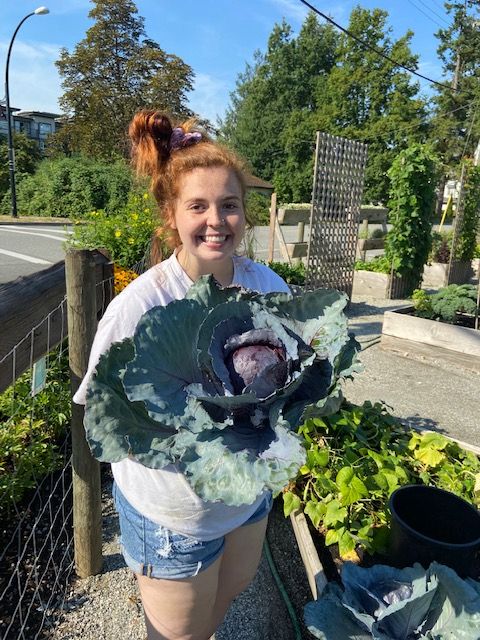In Maple Ridge, British Columbia, you’ll find an Intergenerational Garden that has been nourishing its community for almost 10 years.
Through the garden project, young students, seniors and teachers are growing and learning together. Seniors are passing down important knowledge, and young people are learning how to grow food and care for a garden.
The project has grown into a real gift for the whole community.

How it all began
The Intergenerational Garden project grew out of community consultations led by the Maple Ridge, Pitt Meadows, Katzie, Seniors Network, which administers the garden. The consultations showed that seniors wanted meaningful volunteer opportunities, and many had a particular interest in gardening. It was also understood this would be of great benefit to younger generations.

After the consultations, Heather Treleaven, Executive Director of the Seniors Network, worked with staff at the City of Maple Ridge to apply for funding from the federal government’s New Horizons for Seniors Program. With this funding, they were able to construct a garden across the street from two elementary schools, who partnered with them for this project. (The garden is on land owned by the City of Maple Ridge, which provides them with water access.)
A Garden Advisory Committee was formed early on, which helped reap plenty of knowledge along the way; staff at the local CEED Centre shared insight, as well as the senior volunteers and folks on the Board at the Seniors Network.
Makenna Patrick, the Garden Coordinator, explains that all of the senior volunteers bring unique skills and abilities to the garden, resulting in a dynamic learning environment. Some seniors have been with the program since its beginning. Some are even master gardeners. And some are retired school teachers who bring helpful perspectives on curriculum implementation.
The knowledge shared and relationships built have proven to be incredibly valuable. In addition to young students learning about food education, it’s given teachers the opportunity to learn from experienced seniors too — and they’ll be able to bring this knowledge to future classes and generations.
Heather explains that the neighbourhood has really rallied around the garden. Members of the community helped build the garden (Heather herself helped shovel out gravel), firefighters helped with fencing, and local businesses provided a lot of in-kind support (for things like soil, seeds, and the fencing).
Fittingly then, for a real community endeavour, the garden has an open gate policy. Anyone is welcome to come in, sit on the benches, and enjoy the community space.
You can visit the Seniors Network website for more details, including a full list of supporters and funders.
So how does it work?

Each year, roughly 400 students from about 15 different classes participate in the garden. These students are mentored by about 20-30 senior volunteers. Makenna coordinates with the seniors what days everyone is available, and has a curriculum for each grade level.
Each class has a weekly half-hour time slot in the garden. For the first 10 minutes of each lesson, they’ll discuss what they’re going to learn, followed by 20 minutes of hands-on experiential learning in the garden.
Generally, the garden is open from March to June, and then again in September until October or November. The senior volunteers are at the garden year-round, and so provide continuity and maintenance throughout the whole year.
The volunteers aim to meet monthly, depending on current garden projects. Smaller sub-groups of volunteers also meet for various projects (e.g. food bank volunteers, compost volunteers, Indigenous garden bed volunteers).
Both the seniors and students get to enjoy the food grown in the garden, and a large portion is donated to a local food bank. Last year, the garden produced over 500 pounds of food.
Reaping the Rewards
For Makenna and Heather, the most rewarding part has been seeing the garden’s impact — socially, educationally and environmentally.
It’s been special to see relationships bloom between the seniors, students and teachers, and everyone else involved. On top of that, the garden has provided the seniors with purpose and a space where they feel appreciated; and, of course, it has offered the students powerful hands-on education.
Heather and Makenna agree that growing your own food really changes how young people look at food.
It’s been especially meaningful to see the environmental changes the garden is helping to cultivate in young people. “After a lesson on pollinators,” Makenna explains, “we’re hearing students say they planted wildflower seeds at home. It’s special to see these sessions are having direct and immediate impacts outside of the garden.”
Makenna adds that it’s been amazing to see how much students can quickly grasp. “We only spend half an hour every week in the garden, and the amount they learn is incredible. We’ll go over the functions of the five main parts of a plant, and then eat those parts, and you see them so quickly connect their prior learning.”
After COVID lockdowns, it was an added bonus to already have a dedicated outdoor classroom space when students returned to school.
“There’s no end to the fun that goes on,” Heather says. “There’s something new every year, a new opportunity.” Currently, they’re partnering with the David Suzuki Foundation via the Butterfly Ways Project.
Although it wasn’t an initial goal of the garden, donating to their local food bank has become a significant part of the project as well. This has led to important conversations with the students surrounding food security, too.
Top Tips and Factors for Success
Both Makenna and Heather agree that the biggest factor for success has been the community involvement.
“The garden is such a large project,” Makenna explains, “without such a variety of skills, opinions and types of people, the garden would not be as dynamic and beautiful as it is. It really is a collage of everyone that’s been involved.”

For Heather, having a paid position like Makenna’s has also been a major key to their success. The funded position is possible due to the non-profit partnership with the Seniors Network. The Seniors Network takes care of grant writing, promoting the project in the community and connecting with local businesses for in-kind donations. There are quite a few grant opportunities available to start garden projects. The challenge is finding funders willing to help keep a good thing going. In the future, they hope to see a position like Makenna’s turn into a District-wide position coordinating gardens at numerous schools, including high schools.
If you’re as inspired as we are by this intergenerational garden, here are some top tips from Heather & Makenna:
- Start small — there’s a lot of moving parts to a community-based garden, so sometimes you have to scale yourself back and accept your limitations.
- Reach out to your community and don’t be afraid to ask for help — there is a lot of knowledge and support out there (e.g. when this garden team was looking to secure funding, they put a story out in their local newspaper about how they were at risk of closing, which led to some funders and private businesses offering support.)
- Don’t underestimate what kids can do! Hold your students to a high standard and you’ll see the impressive things they can achieve.
- The volunteers’ attitudes will follow your attitude, so it’s important to be positive.
- View challenges as learning opportunities! (e.g. when this team was dealing with bugs in the garden, they viewed it as a learning opportunity for everyone, as they compot to learn what millipede leaf damage looked like and how to address it.)
- Try to partner with a community organization, non-profit or service club (they may be able to provide funding for a garden coordinator!)
- Search out grant opportunities — this year, the Intergenerational Garden is 1 of 6 recipients of a 2022 Scotts Canada Gro for Food Grant. Bravo!
While the initial intention of the garden was to build meaningful opportunities for seniors to share their knowledge, the project has accomplished that and so much more. Relationships are blossoming, food security efforts are being supported, and quality environmental education has increased for students and teachers that will continue to grow for years to come.




